Acura RL 2000 3.5 Owner's Manual
Manufacturer: ACURA, Model Year: 2000, Model line: RL, Model: Acura RL 2000Pages: 330, PDF Size: 4.53 MB
Page 291 of 330
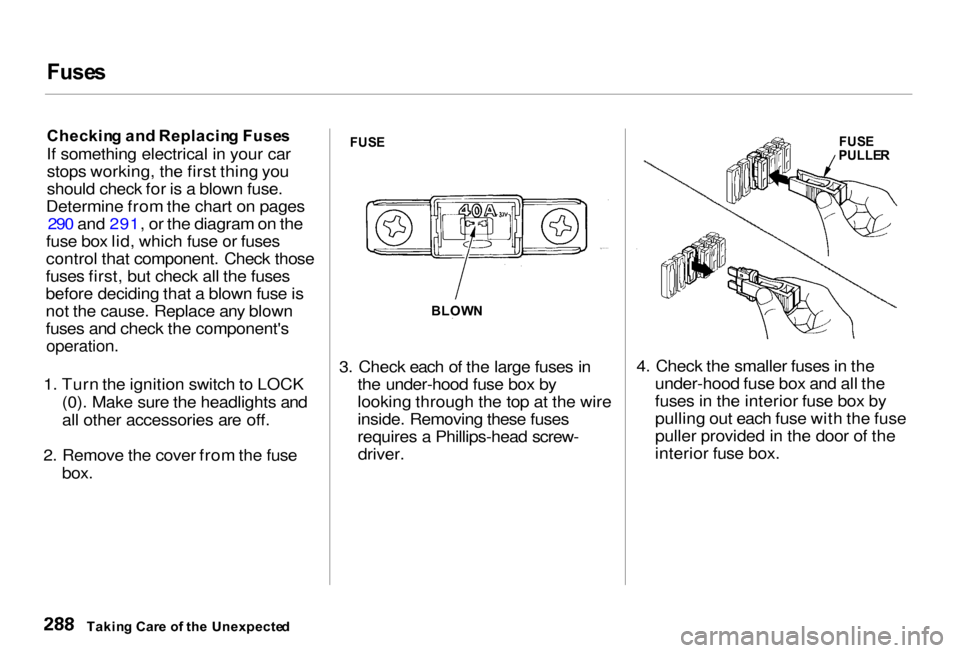
Fuse
s
Checkin g an d Replacin g Fuse s
If something electrical in your car stops working, the first thing you
should check for is a blown fuse.
Determine from the chart on pages 290 and 291, or the diagram on the
fuse box lid, which fuse or fuses
control that component. Check those
fuses first, but check all the fuses
before deciding that a blown fuse is
not the cause. Replace any blown
fuses and check the component's
operation.
1. Turn the ignition switch to LOCK (0). Make sure the headlights and
all other accessories are off.
2. Remove the
cover from the fuse
box.
FUS
E
3.
Check each
of the large fuses in
the under-hoo
d fuse box by
looking through the top at the wire
inside. Removing these fuses
requires a Phillips-head screw- driver. 4. Check the
smaller fuses in the
under-hood fuse box and all the
fuses in the interior fuse box by
pulling out each fuse with the fuse
puller provided in the door of
the
interior fuse box.
Takin g Car e
o
f th e Unexpecte d
BLOW
N
FUS
E
PULLE R
Page 292 of 330
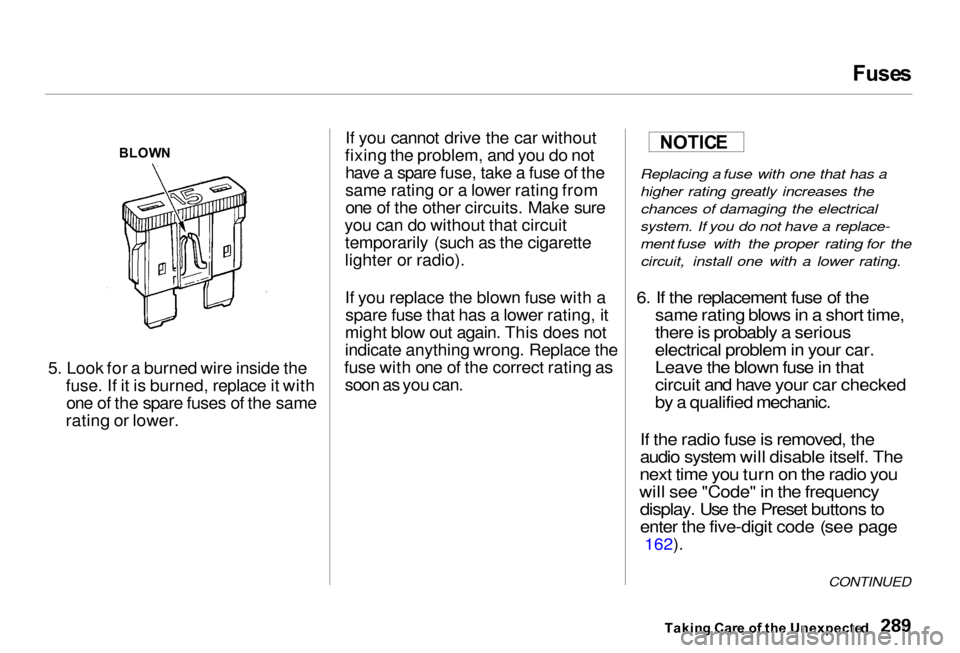
Fuse
s
5. Look for a burned wire inside the fuse. If it is burned, replace it withone of the spare fuses of the same
rating or lower. If you cannot drive the car without
fixing the problem, and you do not have a spare fuse, take a fuse of the
same rating or a lower rating from
one of the other circuits. Make sure
you can do without that circuit temporarily (such as the cigarette
lighter or radio).
If you replace the blown fuse with aspare fuse that has a lowe r rating, it
might blo
w out again. This does not
indicate anything wrong. Replace the
fuse with one of the correct rating as soon as you can.
Replacing a fuse with one that has a
higher rating greatly increases the
chances of damaging the electrical
system. If you do not have a replace-
ment fuse with the proper rating for the circuit, install one with a lower rating.
6. If the replacement fuse of the same rating blows in a short time,
there is probably a serious
electrical proble
m in your car.
Leave the
blown fuse in that
circuit and have your car checked
b
y a
qualified mechanic.
If th
e radio fuse is removed, the
audio system will disable itself. The
next time you turn on the radio you
will see "Code" i
n the frequency
display. Us
e the Preset buttons to
enter the five-digit code (see page
162).
Takin g Car e o f th e Unexpecte d
BLOW
N
CONTINUED
NOTIC
E
Page 293 of 330

Fuse
s
UNDER-HOO D FUS E BO X
Takin g Car e o f th e Unexpecte d
Page 294 of 330

Fuse
s
Takin g Car e o f th e Unexpecte d
INTERIO
R FUS E BO X
* 1 : On Canadian models
Page 295 of 330

Emergenc
y Towin g
If your car needs to be towed, call a
professional towing service or, if you
belong to one, an organization that
provides roadside assistance. Never
tow your car behind another vehicle
with just a rope or chain. It is very
dangerous.
There are three popular types of professional towing equipment:
Flat-bed Equipment — The operator
loads your car on the back of a truck.
Thi s is th e bes t wa y to transpor t
you r Acura .
Wheel-Lift Equipment — The tow
truck uses two pivoting arms that go
under the tires (front or rear) and lift
them off the ground. The other two
tires remain on the ground. Thi s i s
a n acceptabl e wa y to to w you r
Acura .
Sling-type Equipment — The tow
truck uses metal cables with hooks on the ends. These hooks go around
parts of the frame or suspension and
the cables lift that end of the car off the ground. Your car's suspensionand body can be seriously damaged.
Thi s metho d o f towin g is
unacceptable .
If your Acura cannot be transported
by flat-bed, it should be towed by
wheel-lift equipment with the front
wheels off the ground. If, due to damage, your car must be towed
with the front wheels on the ground, do the following. Release the parking brake.
Shift the transmission to Neutral.
Improper towing preparation will
damage the transmission. Follow the
above procedure exactly. If you cannot
shift the transmission or start theengine, your car must be transportedwith the front wheels off the ground.
With the front wheels on the ground, it is best to tow the car no farther
than 50 miles (80 km), and keep thespeed below 35 mph (55 km/h).
Takin g Car e o f th e Unexpecte d
NOTIC
E
Page 296 of 330
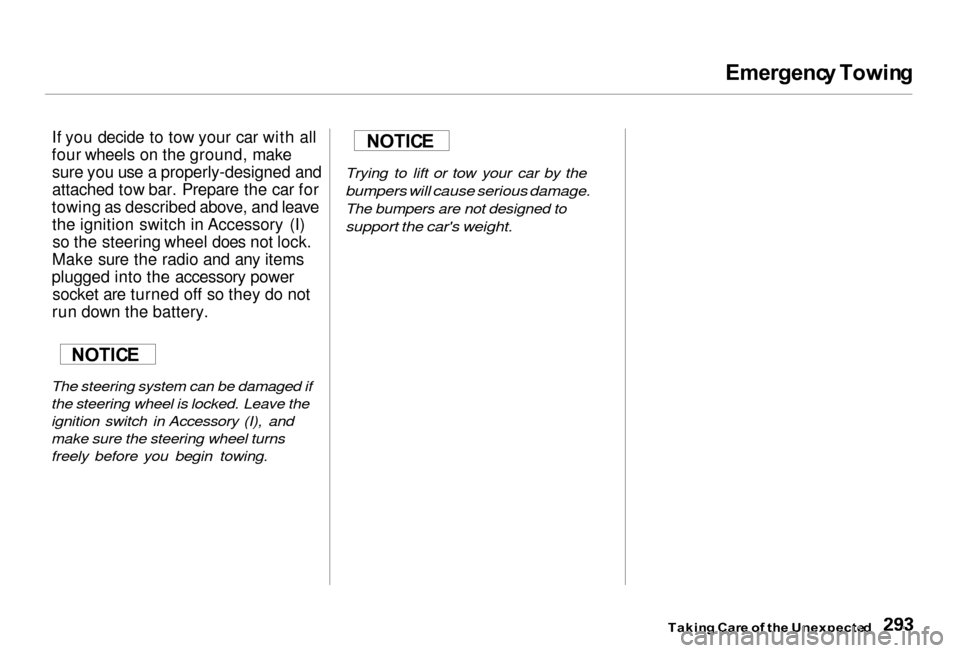
Emergenc
y Towin g
If you decide to tow your car with all
four wheels on the ground, make sure you use a properly-designed and
attached tow bar. Prepare the car for
towing as described above, and leave the ignition switch in Accessory (I)so the steering wheel does not lock.
Make sure the radio and any items
plugged into the accessory power socket are turned off so they do not
run down the battery.
The steering system can be damaged if
the steering wheel is locked. Leave the
ignition switch in Accessory (I), and
make sure the steering wheel turns
freely before you begin towing. Trying to lift or tow your car by the
bumpers will cause serious damage.
The bumpers are not designed to
support the car's weight.
Taking Car e o f th e Unexpecte d
NOTIC
E
NOTIC E
Page 297 of 330

294
Page 298 of 330
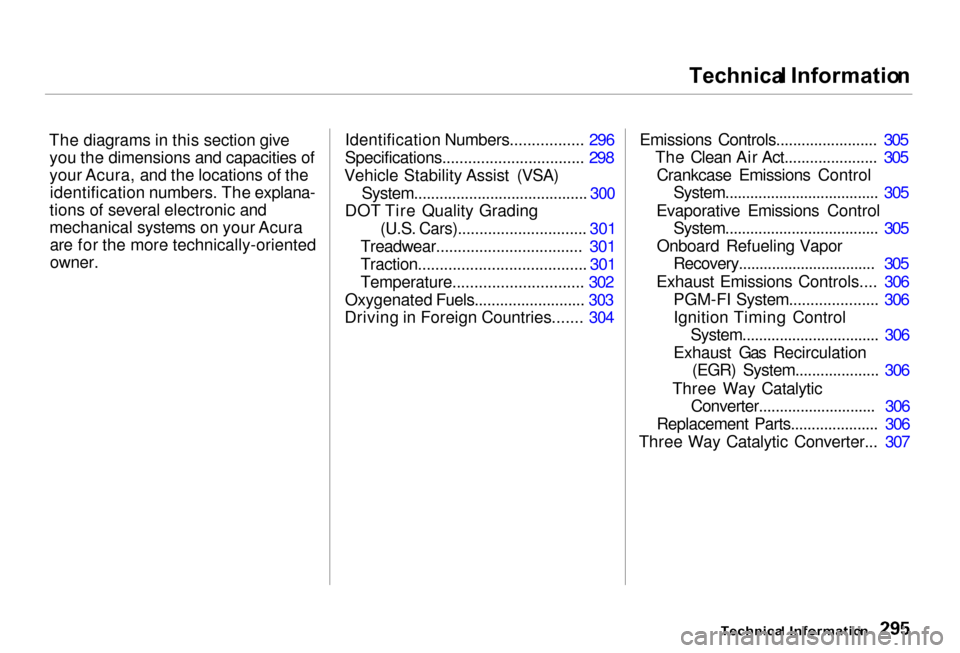
Technica
l Informatio n
The diagrams in this section give you the dimensions and capacities of
your Acura, and the locations of theidentification numbers. The explana-
tions of several electronic and
mechanical systems on your Acura are for the more technically-oriented
owner. Identification Numbers................. 296
Specifications................................. 298
Vehicle Stability Assist (VSA) System......................................... 300
DOT Tire Quality Grading
(U.S. Cars).............................. 301
Treadwear.................................. 301
Traction....................................... 301
Temperature.............................. 302
Oxygenated Fuels.......................... 303
Driving in Foreign Countries....... 304 Emissions Controls........................ 305
The Clean Air Act...................... 305
Crankcase Emissions Control System..................................... 305
Evaporative Emissions Control System..................................... 305
Onboard Refueling Vapor Recovery................................. 305
Exhaust Emissions Controls.... 306 PGM-FI System..................... 306
Ignition Timing ControlSystem................................. 306
Exhaust Gas Recirculation (EGR) System.................... 306
Three Way Catalytic Converter............................ 306
Replacement Parts..................... 306
Three Way Catalytic Converter... 307
Technical Informatio n
Page 299 of 330
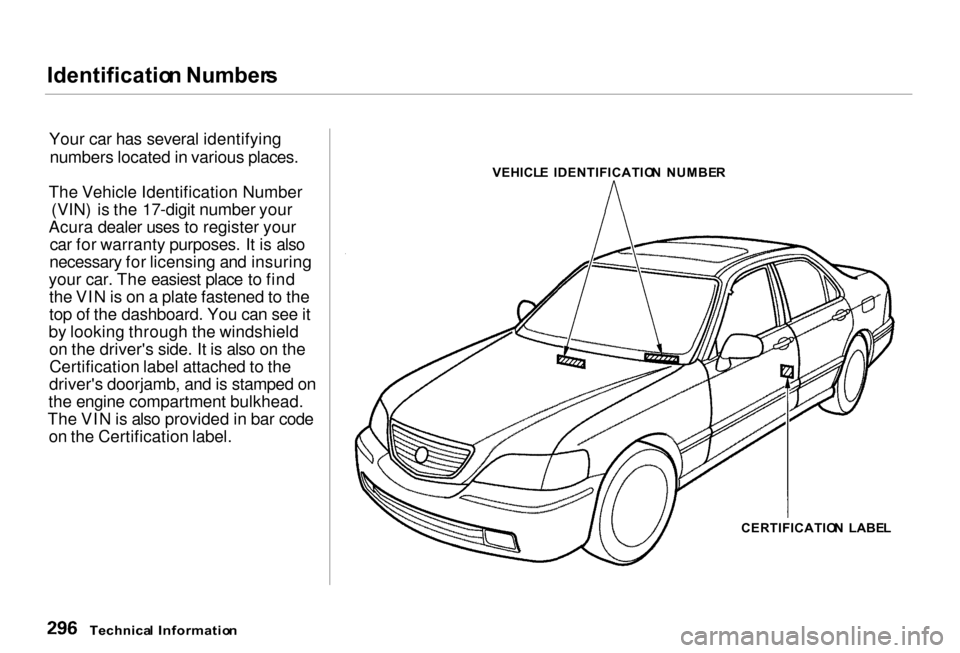
Identificatio
n Number s
Your car has several identifying numbers located in various places.
The Vehicle Identification Number (VIN) is the 17-digit number your
Acura dealer uses to register your car for warranty purposes. It is also
necessary for licensing and insuring
your car. The easiest place to find the VIN is on a plate fastened to the
top of the dashboard. You can see it
by looking through the windshield on the driver's side. It is also on theCertification label attached to the
driver's doorjamb, and is stamped on
the engine compartment bulkhead.
The VIN is also provided in bar code on the Certification label.
Technica l Informatio n
VEHICL
E IDENTIFICATIO N NUMBE R
CERTIFICATIO N LABE L
Page 300 of 330

Identificatio
n Number s
The Engine Number is stamped into the engine block. It is on the front
left, below the valve cover.
The Transmission Number is on a label on top of the transmission.
Technical Informatio n
TRANSMISSIO
N NUMBE R
ENGIN E NUMBE R